WildApricot is a cloud-based membership software solution. It’s becoming a more and more popular platform of this type, at least judging from the number of monthly visits, traffic and engagement stats, and big ranking jumps, as well as other relevant stats.

WildApricot was primarily designed to meet the needs of membership-driven organizations, such as clubs, nonprofits, and other similar types of associations. As such, it may not be suitable for just any membership venture. However, if this web platform has been on your radar for a while, you have a pretty good idea of how it works, and you believe that it would be a good fit for your organization, then its pricing is surely one of the things that you’d like to learn more about.
In our guide on the WildApricot pricing system, we’ll explore this platform’s pricing plans, look at the available billing options, learn the details about its free trial, and try to provide as much helpful information as possible on the not-so-obvious fees and additional costs that you can incur. So, buckle up, settle in for a good ride, and let’s embark together on a journey into the WildApricot pricing system.
Table of Contents
The Pricing Plans
WildApricot differs from any other platform that we’ve had the privilege to try and learn about in that it offers as many as eight pricing plans. That’s a pretty big number for pricing plans, don’t you think?
The crucial difference between the plans is the number of allowed contacts. This is actually the defining feature that separates each plan from the others. Two more features vary among the plans they set apart: the storage limit and the number of admins. However, considering that there’s only one plan that includes less storage space and a lower number of admin accounts, these features are not nearly as important a factor as the number of contacts.
Be that as it may, let’s look at the WildApricot pricing plans, and we’ll let you judge what’s worth your attention.
The Free Plan
The Free plan is an excellent way to gain hands-on experience with the platform without any financial commitments. Free plans are always great to have in any pricing system, but as you might have guessed, the Free plan doesn’t include all of the features and perks available with the paid plans. Let’s explore the WildApricot free offering and see what its features and limitations are.
Contacts
For starters, with a Free account, you can have up to a maximum of 50 contacts. Keep in mind that contacts are not the same as members. All members are contacts, but not all contacts are members, so you may have, for example, 50 contacts but far fewer members signed up.
So, simply put, contacts are users whose information you manage to collect so you can send them emails with informative and/or promotional content. On the other hand, members become only those contacts who decide to pay a membership fee to get access to your exclusive behind-a-paywall content (or whatever it is that you offer on your membership site).
Taking this into account, you can see how the maximum of 50 contacts can be a significant limitation for someone who plans on building a large membership.
Storage Space and Admins
The Free plan includes only one admin account and 100 MB storage space, which makes it unique. All of the paid plans share the same number of admins and the same amount of storage space, which we’ll talk about later in this section.
Included Features
The list of included Free plan features contains the following tools:
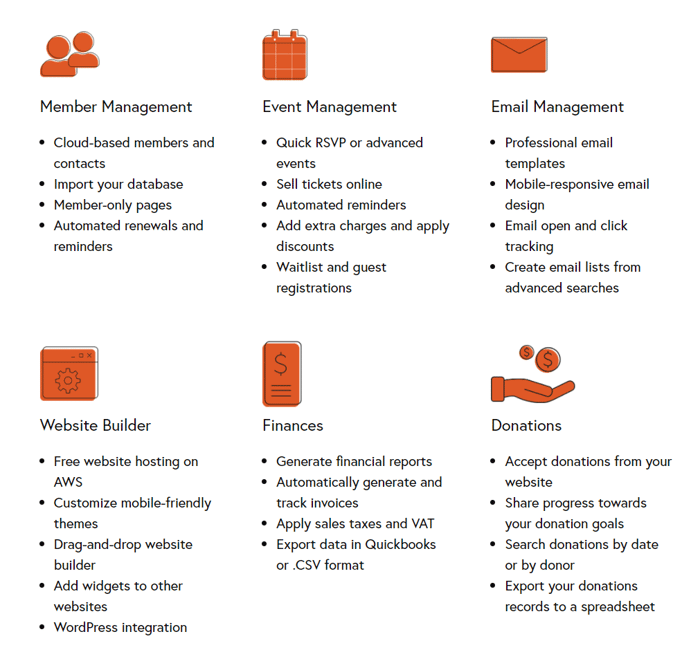
Still a pretty good list of features, isn’t it? Now, let’s look at what’s missing in the Free plan.
Excluded Features
The features that the Free account excludes, but each of the paid plans includes, are the following:
- Online payments: You can’t add a payment gateway, so you can’t accept payments.
- Online store: Without the ability to receive payments, an online store wouldn’t make any sense.
- Custom domain: This means that you’ll miss out on the opportunity to build stronger brand awareness.
- Theme overrides: With this feature missing from your feature set, you won’t be able to do advanced theme design customization.
- Site search gadget: You can’t put a search box on any of your site pages, so visitors won’t be able to search through your site and more easily find what they need.
- Scheduled emails: The Free plan doesn’t allow you to manually schedule emails for later time.
- Mobile apps: WildApricot has separate iOS mobile apps and Android apps for admins and members, but they’re not part of the Free offering.

- Chat support: With the Free plan, you cannot use the live chat support available to all of the paid plans’ subscribers (during workdays).
Even though this is a long list of excluded features, you’ll be hard-pressed to find many membership and business solution platforms that offer a free plan without significant limitations or that offer a free plan at all.
Also, on an even brighter note, keep in mind that the Free plan allows you to integrate third-party software like the content marketing and blogging app DropInBlog, which can bring so many more opportunities than what you get out of the box. All in all, the Free plan is far from being as bad a deal as the list of excluded features might suggest.
The Paid Pricing Plans
As we implied earlier, the paid pricing plans only differ from each other in the contact numbers. They all share the same storage limit of 2 GB and an unlimited number of admin accounts. They all include the core features that the Free plan includes plus the features excluded from the Free plan.
Since we already went over both the core features and the excluded features, the only thing left for us to do regarding the paid plans is to look at the subscription fees and the different numbers of contacts.
The Personal Plan
WildApricot offers three billing types: monthly, annual, and bi-annual. The annual billing includes a 10% discount, while with a bi-annual subscription you get a 15% discount. The discounts apply to each paid plan, regardless of whether it is the lowest or highest-tier you subscribe to.
The Personal plan fees are the following:
- Monthly billing: $48/month
- Annual billing: $43.20/month
- Bi-annual billing: $40.80/month
This pricing plan allows 100 contacts maximum.
The Group Plan
The Group plan is priced at:
- Monthly billing: $60/month
- Annual billing: $54/month
- Bi-annual billing: $51/month
With a Group account, you can’t have more than 250 contacts.
The Community Plan
The Community plan costs:
- Monthly billing: $110/month
- Annual billing: $99/month
- Bi-annual billing: $93.50/month
It allows you to have up to 500 contacts.
The Professional Plan
The Professional plan subscription fees are the following:
- Monthly billing: $190/month
- Annual billing: $171/month
- Bi-annual billing: $161.50/month
This plan’s subscribers can add up to 2,000 contacts to their contact list.
The Network Plan
The price gap between the Network and Professional accounts is pretty big, but so is the difference in the number of contacts.
If you opt for the Network plan, you’ll have to pay:
- Monthly billing: $350/month
- Annual billing: $315/month
- Bi-annual billing: $297.50/month
The maximum number of contacts with the Network plan is 5,000.
The Enterprise Plan
Considering that this is one of the two highest-tier plans as well as that it caters to the needs of enterprise-level organizations, a higher price is expected. So, if you need many contacts on WildApricot, the Enterprise plan will cost you:
- Monthly billing: $420/month
- Annual billing: $378/month
- Bi-annual billing: $357/month
At these prices, you can have as many as 15,000 contacts.
The Global Plan
This is the last and most expensive WildApricot plan. You can subscribe to it for the steep prices of:
- Monthly billing: $720/month
- Annual billing: $648/month
- Bi-annual billing: $612/month
With the highest-tier Global account, you can have 50,000 contacts on your list.
WildApricot’s Multi-Chapter Pricing
Multi-chapter organizations are those that expand to encompass different branches. These branches are not unconnected, and yet, they operate as relatively separate entities. WildApricot enables each of the different chapters – whether they’re different regional offices, local branches, or component groups – to create its own stand-alone membership website, use a different payment gateway, and have a separate database.
As it’s clear from the title above, WildApricot seems to have special offerings for this type of organization. However, the multi-chapter pricing is no different from the regular pricing. They’re the same pricing plans spiced up with some extra perks, such as:
- Special discounts for organizations that consist of five different chapters minimum.
- Ability to build a single customizable membership site template for all chapters with the organization branding across-the-board, an about us section, and other features shared between the chapters’ websites.
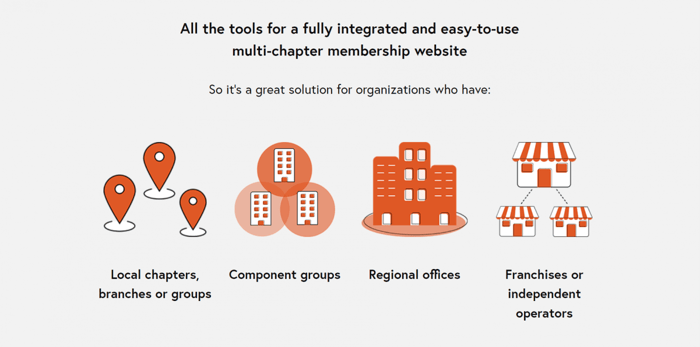
Are WildApricot Prices Fair?
The only relatively frequent complaint in recent reviews of the WildApricot prices is that from the moment Personify acquired the platform in 2017, the prices have constantly been increasing without corresponding improvements in the existing features or the introduction of new ones.
On the other hand, judging from the fact that WildApricot has pretty good ratings on customer review websites like Capterra and is still alive and kicking in 2022, you could say that many organizations consider this membership platform to be an affordable and suitable solution.
The Free Trial
As we implied in the intro, WildApricot does offer a free trial, and right off the bat we can say that this is one of the most exceptional features of the platform’s pricing system. What makes it so appealing?
The Merits of the Free Trial
While it’s more or less usual for platforms to offer a 14-day free trial, WildApricot is an exception. This platform offers a full-month, 30-day free trial. During those 30 days, you’ll get access to the features available with the Community pricing plan (with some limitations).
Another good thing about the free trial and the unusually long trial period is that your data won’t disappear into thin air even if you decide not to continue with any of the paid plans after the free trial expires. WildApricot will keep the data you generate during the trial period intact. The only difference will be that your account will be automatically downgraded to a Free plan account when the trial ends.
The Free Trial and the Community Plan
As we said, the free trial includes certain limitations that you don’t face with a paid Community plan subscription. What are they? The list isn’t long, but you may find that it’s consequential:
- The maximum quantity of site administrators you can have throughout the trial period is five as opposed to the unlimited number of admins available with the Community pricing plan.
- In contrast to the 2 GB of storage limit you get with a Community subscription, the maximum amount of storage space during the free trial is 100 MB.
- The free trial doesn’t include the possibility of using a custom domain.
More on Plan Differences
Fewer admin accounts and less storage space are two features that the free trial has in common only with one other plan – the Free plan.
Technically, the free trial is not a pricing plan, but since it includes everything in the Community plan apart from the number of admins and amount of storage space, we thought that would be sufficient to qualify these two features as plan differences.
Conclusions
Going back to our main topic, we hope you’d agree that a few restrictions hardly put a stain on the WildApricot free trial. This is especially true considering how important it can be for newcomers to have the chance to kick the tires of a platform for a full 30 days.
This period can be more than enough to allow the inexperienced (as well as any other type of user) to familiarize themselves with the platform and build reasonable expectations of how efficient they would be in using it. Also, 30 days sound like plenty of time to establish whether WildApricot would fit well in your plans regarding your membership venture.
Additional Costs
WildApricot doesn’t exactly have costs that we can call hidden, which is the reason why we’re avoiding this word. However, it does include some additional costs that are not so obvious. To the platform’s credit, WildApricot is very transparent when it comes to these. The only thing we need to do is dig a little deeper into the platform’s documentation, and we’ll manage to find what we need.
As a matter of fact, some of the additional costs are very common, if not virtually universal in the online business and management software solutions that include payments. A clear example of these are the standard fees that credit card companies like American Express, Visa, MasterCard, and Discover charge per transaction.
Credit Card Fees
Here, we’ll provide a few images that show the details about the fees charged by the four mentioned credit companies:
Visa
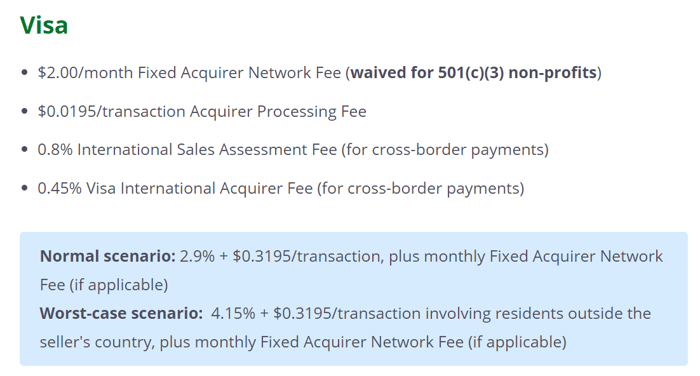
MasterCard
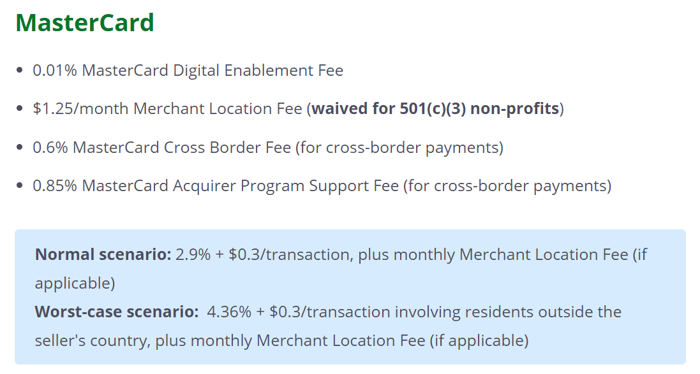
Discover
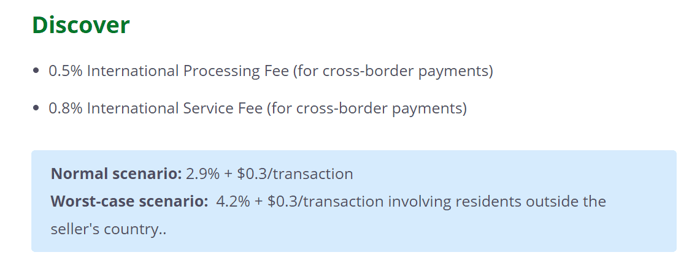
American Express
Unfortunately, there are not that many details on American Express, which is why we left it for the end of the list. The only information on this card that WildApricot provides is that the American Express fees, together with AffiniPay’s fees, amount to 3.5% + $0.30 per transaction.
AffiniPay is the payment system company that powers WildApricot Payments. On its official website, this company has the following information on American Express fees:
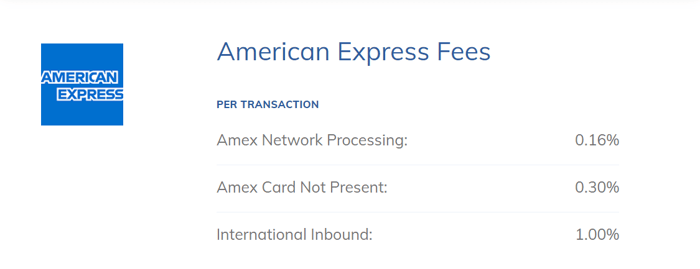
Credit Card Companies, AffiniPay, and WildApricot Payments
WildApricot Payments does charge a transaction fee and the usual amount is 2.9% + $0.30 per transaction. As you must have noticed, this is the same amount from the “normal scenario” of three of the credit card companies’ fees shown in the images above. American Express is the only exception. As was already noted, when someone is paying with American Express, the normal fee scenario is 3.5% + $0.30.
Regardless of the scenario, loosely speaking we can call the WildApricot Payments’ transaction fees composite. The reason is that they consist of the credit card company’s own fees together with AffiniPay’s fees. This implies that WildApricot itself doesn’t take any cuts from any payment transactions. It’s the credit card company together with the payment system company (that powers WildApricot Payments) that charge you for their services any time you receive a payment.
Payment System Fees
We already discussed the WildApricot Payments fees, so why are we talking about payment system fees again? Well, because these payment fees are of a different type.
Starting from July 2019, WildApricot decided to charge 20% per transaction every time a WildApricot customer “based in the US and Canada” uses a payment processing system that’s not WildApricot Payments. Currently, the platform allows you to use Stripe, PayPal, and Authorize.net. So, if your organization operates from one of the two aforementioned countries, and you opt for one of the three third-party payment gateways, you’ll have to pay a pretty steep fee whenever you receive a payment.
Based on WildApricot’s explanation, the company decided to take this step because when a client uses a third-party payment processor, this indirectly takes away from the funds that the platform invests in its own payment system. Since this hinders the refinement of the existing payment-related features and prevents the development of new ones, the company chose to discourage the use of third-party payment systems by imposing high transaction fees.
Over and Out
To summarize our review of WildApricot’s pricing, let’s mention the important aspects that you need to keep in mind:
- WildApricot has eight pricing plans, with a special emphasis on the free offering.
- WildApricot has an uncommonly generous full-month free trial.
- There are certain not-so-obvious credit card transaction fees.
- There are payment processing fees.
We sincerely hope that this was sufficient for you to give a clear picture of the WildApricot pricing system and what features the different types of accounts include.
So now that you know more about the WildApricot pricing and can combine this with the rest of your knowledge about this membership platform, how do you feel about trying it out? Do you think it would be worth your time? How about choosing it as a long-term solution? Hopefully, you have all the right answers to these questions.




